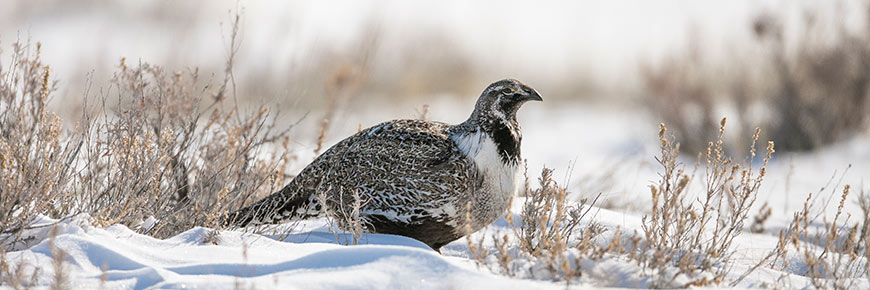
Neil Fisher / © Parks Canada
Greater Sage-Grouse
Grasslands National Park
Greater sage-grouse are one of Canada’s most iconic grassland species. This large grouse is known for its incredible courtship display. Every spring, male birds gather at their breeding grounds, called “leks”, to perform an elaborate dance, hoping to impress females watching nearby. As the males strut and fan their tails, they inflate and deflate brightly coloured air sacs on their chest creating popping sounds that can be heard up to 3 km away. After a hen chooses a male to mate with, she builds her nest amongst the sagebrush, using it as cover from predators. Once her eggs have hatched and the chicks are ready to leave the nest, the brood stays with their mother as they search for insects and wildflowers to supplement their diet of sagebrush leaves and buds. As winter sets in, Greater sage-grouse diet shifts to 100% sagebrush.
Once abundant across the Great Plains of North America, the Greater sage-grouse has experienced significant population declines and range contraction. In Canada, Sage-grouse occupy about 7% of their historic range and have declined by approximately 82-92% in less than two decades (1998-2012). As a result, these birds are listed as endangered under the federal Species at Risk Act (SARA). Few small and relatively isolated populations can be found in southwestern Saskatchewan and southeastern Alberta. Grasslands National Park is home to the only two remaining leks left in Saskatchewan, and currently protects just over half the birds remaining in Canada. Based on the most recent monitoring efforts, it is estimated that approximately 50-80 birds live in Grasslands National Park (both East and West Block.)
Greater sage-grouse are threatened by a number of factors that can co-occur to have a major impact on the survival and recovery of this species. Land conversion of sagebrush grasslands, through cultivation and energy development has been a leading cause of the decline of Greater sage-grouse. After habitat loss, the small, fragmented, remaining patches of intact sagebrush grasslands make it difficult for individuals to move between neighbouring populations and between summer and winter grounds. The associated infrastructure that accompany these land-use changes, including roads, power lines and noise, can also have a large impact on birds. Overhead power lines and fences have increased the availability of perch sites for avian predators like owls and crows, which can have a significant impact on nestling and adult mortality. The small population of birds left in Canada also make them more susceptible to extreme weather events and disease.
Enhancing and Restoring Habitat for this Iconic Prairie Species
Grasslands National Park is working to preserve, enhance and restore the sagebrush ecosystem that Greater sage-grouse depend on. Between 2016 and 2018, the Park collaborated with the University of Alberta and volunteers to plant over 9000 sagebrush plugs and seed sagebrush and native forb seeds leading to the enhancement of over 90 ha of sage-grouse habitat.
The park has also partnered with local stakeholders and neighbours to introduce and maintain beneficial grazing regimes that promotes habitat heterogeneity and optimizes sage-grouse nesting and brood-rearing habitat.
In 2020, Grasslands National Park initiated a project that aims to restore a previously cultivated field to the historical sagebrush dominant community. Over the next 5 years, the Park will remove agronomic species using both chemical and mechanical means while developing a locally-sourced native seed mix in preparation for planting. If successful, this work will restore approximately 30 ha of sagebrush habitat in the Park and inform decisions on land use planning in support of sage grouse recovery.
Finally, the Park is working to reduce the impact of anthropogenic structures on Greater sage-grouse. Collisions with fence lines is a common source of mortality for many species of grouse, including the Greater sage-grouse. Studies have shown that by marking fence lines with coloured markers you can reduce collisions by approximately 83%. In order to minimize the risk of collision and mortality, Grasslands National Park has removed 63.1 km of fences and marked an additional 77.3 km of fence line in priority sage-grouse habitat. In the fall of 2020, Grasslands National Park partnered with SaskPower to remove 10.9 km of overhead power line within Greater sage-grouse critical habitat. This effort is part of a larger program that will remove vertical structures that may result in sage-grouse avoidance or increased predation risk.
How You Can Help
If you see a Greater-sage grouse while visiting Grasslands National Park, let Parks Canada staff know. Not much is known about these birds once they leave the breeding ground so you can help us learn more by reporting your sighting! When you do, provide a reference location (GPS coordinates are extremely helpful) and if you were lucky enough to get one without disturbing the bird, any pictures you have.
Connecting with nature
Did you know?
Despite their large size, Greater-sage grouse are strong fliers! Though sage-grouse don’t migrate like some other grassland songbirds, some may move from their summer range to winter range, seeking out areas with less snow. The longest known Sage-grouse migration occurred right here in Saskatchewan, where birds from Grasslands National Park flew up to 193 kilometers south to spend winter in Montana.
How to identify:
Greater sage-grouse or Sharp-tailed grouse? Sage-grouse are very rare in Canada while Sharp-tailed grouse are comparably common. Sage-grouse only exist in large tracts of sagebrush habitat. You may spot Sharp-tailed grouse hanging out in the trees but you won’t find Sage-grouse there. If you’re still not sure, look for the dark black belly of male and female Greater sage-grouse in contrast with the pale belly of Sharp-tailed grouse!
- Date modified :